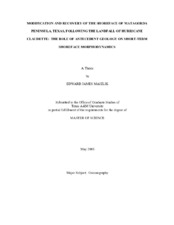| dc.description.abstract | Matagorda Peninsula is located along an interfluvial region of the central Texas coast in the northwestern Gulf of Mexico. The Pleistocene Beaumont Clay underlies the coastal plain and inner continental shelf and controls the general slope of the coast in this region. This clay surface also creates low accommodation space for the preservation of modern sediments. As a result, only a thin (1 m) layer of transgressive Holocene muddy sand extends throughout the lower shoreface. On 15 July, 2003, Hurricane Claudette (Category 1) made landfall on the peninsula. Following the storm, the shoreface was found to be an extensively eroded surface. Most obvious on this surface was an area containing numerous scour pits on the lower shoreface. These pits extended through the Holocene sediment and into the underlying Beaumont Clay. By the following July, the shoreface exhibited a relatively flat and featureless appearance. Rapid infilling of the pits was attributed to the high sediment supply to the area from converging longshore currents and by the relatively high accommodation space offered by the scoured areas. A large amount of sediment was removed from the lower shoreface where the formation of scour pits occurred. This sediment would have been available for depositionin storm layers both inshore and offshore of the scoured area. Within scour pits, accommodation space was high, resulting in sediment deposition and rapid infilling of the pits. Outside of the scour pits, accommodation space remained low and sediment deposition did not occur. Preservation potential of the sediment record on the shoreface was low and was controlled by cycles of erosion and deposition during storm events. Antecedent geology of the shoreface and the sedimentary processes occurring during and after the storm supported arguments against the assumptions used by the classic "profile of equilibrium" model. Finally, the heavily scoured surface represents a geohazard to development of nearshore regions. | en |


